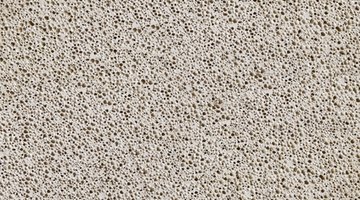Colors of Pumice
Pumice is the solid form of lava that erupts from a volcano. When rapid depressurization and cooling occur, the liquid lava becomes a solid. Pumice is used as a stone carving tool, an additive for cement, and a plaster-like concrete. It is also used as an abrasive in erasers, exfoliants, and to fade stone-washed jeans. Depending on where and how pumice forms it can come in several different colors.
Light Gray and Dark Gray

More often than not, the formation of pumice from volcanic eruption results in a light-gray or dark-gray stone. The light-gray varieties of pumice are typically surrounded by a colorless, transparent groundmass (fine grains in the rock that surround larger particles like crystals) with very few deposits of iron ions (called microcrysts) held within the stone. On the other hand, the dark-gray manifestation of pumice has several streaks of magnetite or hematite microcrysts, bordered by a glass-like, colorless groundmass.
Brown and Black
Additional pumice colors are determined by the other types of microcrysts and groundmasses associated with the stone. Brown pumice is formed when a mixed groundmass of brown and opaque microcrysts occur in the solidified lava. Black pumice is caused by submicroscopic microcrysts of magnetite. Some black pumice may also occur as a result of high water to magma ratio during eruption. This ratio can occur when a volcano erupts into or near a body of water and the magma quickly cools after coming into contact with the water.
Buff and White
Pumice sometimes manifests as buff, a light yellowish color. Buff pumice is similar to its formation as light gray; it can occur when a transparent, colorless groundmass is present with few microcrysts. Lighter colored pumice stones are thought to occur when there is more silica present, which may contribute to the formation of buff and white pumice.
Reddish-Black and Streaks
Pumice sometimes forms a color that is best described as reddish-black. This color may occur when the pumice has formed with the presence of sulfur. Multiple colors of pumice can occur when one type mixes with another at the time of hardening, creating streaks of color. This occurs when there are several different conditions of microcrysts and groundmasses that occur in the same area.
References
Writer Bio
Bryan Cohen has been a writer since 2001 and is a graduate of the University of North Carolina at Chapel Hill with a double degree in English and dramatic art. His writing has appeared on various online publications including his personal website Build Creative Writing Ideas.
Photo Credits
- pumice stone image by Avesun from Fotolia.com
More Articles



